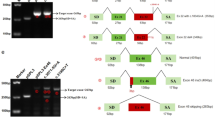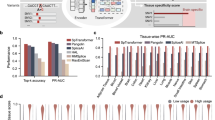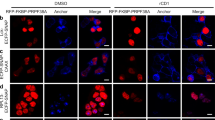Abstract
Precise spatiotemporal regulation of splicing is mediated by splicing cis-elements on pre-mRNA. Single-nucleotide variations (SNVs) affecting intronic cis-elements possibly compromise splicing, but no efficient tool has been available to identify them. Following an effect-size analysis of each intronic nucleotide on annotated alternative splicing, we extracted 105 parameters that could affect the strength of the splicing signals. However, we could not generate reliable support vector regression models to predict the percent-splice-in (PSI) scores for normal human tissues. Next, we generated support vector machine (SVM) models using 110 parameters to directly differentiate pathogenic SNVs in the Human Gene Mutation Database and normal SNVs in the dbSNP database, and we obtained models with a sensitivity of 0.800±0.041 (mean and s.d.) and a specificity of 0.849±0.021. Our IntSplice models were more discriminating than SVM models that we generated with Shapiro–Senapathy score and MaxEntScan::score3ss. We applied IntSplice to a naturally occurring and nine artificial intronic mutations in RAPSN causing congenital myasthenic syndrome. IntSplice correctly predicted the splicing consequences for nine of the ten mutants. We created a web service program, IntSplice (http://www.med.nagoya-u.ac.jp/neurogenetics/IntSplice) to predict splicing-affecting SNVs at intronic positions from −50 to −3.
Similar content being viewed by others
Log in or create a free account to read this content
Gain free access to this article, as well as selected content from this journal and more on nature.com
or
References
Black, D. L. Mechanisms of alternative pre-messenger RNA splicing. Annu. Rev. Biochem. 72, 291–336 (2003).
Jurica, M. S. & Moore, M. J. Pre-mRNA splicing: awash in a sea of proteins. Mol. Cell. 12, 5–14 (2003).
Reed, R. Initial splice-site recognition and pairing during pre-mRNA splicing. Curr. Opin. Genet. Dev. 6, 215–220 (1996).
Gooding, C., Edge, C., Lorenz, M., Coelho, M. B., Winters, M., Kaminski, C. F. et al. MBNL1 and PTB cooperate to repress splicing of Tpm1 exon 3. Nucleic Acids Res. 41, 4765–4782 (2013).
Krawczak, M., Thomas, N. S., Hundrieser, B., Mort, M., Wittig, M., Hampe, J. et al. Single base-pair substitutions in exon-intron junctions of human genes: nature, distribution, and consequences for mRNA splicing. Hum. Mutat. 28, 150–158 (2007).
Sterne-Weiler, T., Howard, J., Mort, M., Cooper, D. N. & Sanford, J. R. Loss of exon identity is a common mechanism of human inherited disease. Genome Res. 21, 1563–1571 (2011).
Cartegni, L., Wang, J., Zhu, Z., Zhang, M. Q. & Krainer, A. R. ESEfinder: a web resource to identify exonic splicing enhancers. Nucleic Acids Res. 31, 3568–3571 (2003).
Goren, A., Ram, O., Amit, M., Keren, H., Lev-Maor, G., Vig, I. et al. Comparative analysis identifies exonic splicing regulatory sequences—the complex definition of enhancers and silencers. Mol. Cell 22, 769–781 (2006).
Wang, Z., Rolish, M. E., Yeo, G., Tung, V., Mawson, M. & Burge, C. B. Systematic identification and analysis of exonic splicing silencers. Cell 119, 831–845 (2004).
Zhang, Z. & Krainer, A. R. Involvement of SR proteins in mRNA surveillance. Mol. Cell 16, 597–607 (2004).
Zhang, X. H., Kangsamaksin, T., Chao, M. S., Banerjee, J. K. & Chasin, L. A. Exon inclusion is dependent on predictable exonic splicing enhancers. Mol. Cell. Biol. 25, 7323–7332 (2005).
Fairbrother, W. G., Yeh, R. F., Sharp, P. A. & Burge, C. B. Predictive identification of exonic splicing enhancers in human genes. Science 297, 1007–1013 (2002).
Desmet, F. O., Hamroun, D., Lalande, M., Collod-Beroud, G., Claustres, M. & Beroud, C. Human Splicing Finder: an online bioinformatics tool to predict splicing signals. Nucleic Acids Res. 37, e67 (2009).
Piva, F., Giulietti, M., Nocchi, L. & Principato, G. SpliceAid: a database of experimental RNA target motifs bound by splicing proteins in humans. Bioinformatics 25, 1211–1213 (2009).
Piva, F., Giulietti, M., Burini, A. B. & Principato, G. SpliceAid 2: a database of human splicing factors expression data and RNA target motifs. Hum. Mutat. 33, 81–85 (2012).
Divina, P., Kvitkovicova, A., Buratti, E. & Vorechovsky, I. Ab initio prediction of mutation-induced cryptic splice-site activation and exon skipping. Eur. J. Hum. Genet. 17, 759–765 (2009).
Lim, K. H., Ferraris, L., Filloux, M. E., Raphael, B. J. & Fairbrother, W. G. Using positional distribution to identify splicing elements and predict pre-mRNA processing defects in human genes. Proc. Natl. Acad. Sci. USA 108, 11093–11098 (2011).
Chang, T. H., Huang, H. Y., Hsu, J. B., Weng, S. L., Horng, J. T. & Huang, H. D. An enhanced computational platform for investigating the roles of regulatory RNA and for identifying functional RNA motifs. BMC Bioinformatics 14 (), S4 (2013).
Shapiro, M. B. & Senapathy, P. RNA splice junctions of different classes of eukaryotes: sequence statistics and functional implications in gene expression. Nucleic Acids Res. 15, 7155–7174 (1987).
Yeo, G. & Burge, C. B. Maximum entropy modeling of short sequence motifs with applications to RNA splicing signals. J. Comput. Biol. 11, 377–394 (2004).
Gao, K., Masuda, A., Matsuura, T. & Ohno, K. Human branch point consensus sequence is yUnAy. Nucleic Acids Res. 36, 2257–2267 (2008).
Corvelo, A., Hallegger, M., Smith, C. W. & Eyras, E. Genome-wide association between branch point properties and alternative splicing. PLoS Comput. Biol. 6, e1001016 (2010).
Taggart, A. J., DeSimone, A. M., Shih, J. S., Filloux, M. E. & Fairbrother, W. G. Large-scale mapping of branchpoints in human pre-mRNA transcripts in vivo. Nat. Struct. Mol. Biol. 19, 719–721 (2012).
Bitton, D. A., Rallis, C., Jeffares, D. C., Smith, G. C., Chen, Y. Y., Codlin, S. et al. LaSSO, a strategy for genome-wide mapping of intronic lariats and branch points using RNA-seq. Genome Res. 24, 1169–1179 (2014).
Fu, Y., Masuda, A., Ito, M., Shinmi, J. & Ohno, K. AG-dependent 3'-splice sites are predisposed to aberrant splicing due to a mutation at the first nucleotide of an exon. Nucleic Acids Res. 39, 4396–4404 (2011).
Wang, E. T., Sandberg, R., Luo, S., Khrebtukova, I., Zhang, L., Mayr, C. et al. Alternative isoform regulation in human tissue transcriptomes. Nature 456, 470–476 (2008).
Pan, Q., Shai, O., Lee, L. J., Frey, B. J. & Blencowe, B. J. Deep surveying of alternative splicing complexity in the human transcriptome by high-throughput sequencing. Nat. Genet. 40, 1413–1415 (2008).
Trapnell, C., Pachter, L. & Salzberg, S. L. TopHat: discovering splice junctions with RNA-Seq. Bioinformatics 25, 1105–1111 (2009).
Katz, Y., Wang, E. T., Airoldi, E. M. & Burge, C. B. Analysis and design of RNA sequencing experiments for identifying isoform regulation. Nat. Methods 7, 1009–1015 (2010).
Chang, C. C. & Lin, C. J . LIBSVM: A Library for Support Vector Machines. ACM T Intel Syst Tec. 2, Article 27 (2011).
Rahman, M. A., Masuda, A., Ohe, K., Ito, M., Hutchinson, D. O., Mayeda, A. et al. HnRNP L and hnRNP LL antagonistically modulate PTB-mediated splicing suppression of CHRNA1 pre-mRNA. Sci. Rep. 3, 2931 (2013).
Ohno, K., Anlar, B., Ozdirim, E., Brengman, J. M., DeBleecker, J. L. & Engel, A. G. Myasthenic syndromes in Turkish kinships due to mutations in the acetylcholine receptor. Ann. Neurol. 44, 234–241 (1998).
Das, R., Zhou, Z. & Reed, R. Functional association of U2 snRNP with the ATP-independent spliceosomal complex E. Mol. Cell 5, 779–787 (2000).
Zuker, M. Mfold web server for nucleic acid folding and hybridization prediction. Nucleic Acids Res. 31, 3406–3415 (2003).
Gahura, O., Hammann, C., Valentova, A., Puta, F. & Folk, P. Secondary structure is required for 3' splice site recognition in yeast. Nucleic Acids Res. 39, 9759–9767 (2011).
Plass, M., Codony-Servat, C., Ferreira, P. G., Vilardell, J. & Eyras, E. RNA secondary structure mediates alternative 3'ss selection in Saccharomyces cerevisiae. RNA 18, 1103–1115 (2012).
Pervouchine, D. D., Khrameeva, E. E., Pichugina, M. Y., Nikolaienko, O. V., Gelfand, M. S., Rubtsov, P. M. et al. Evidence for widespread association of mammalian splicing and conserved long-range RNA structures. RNA 18, 1–15 (2012).
Ohno, K., Engel, A. G., Shen, X. M., Selcen, D., Brengman, J., Harper, C. M. et al. Rapsyn mutations in humans cause endplate acetylcholine-receptor deficiency and myasthenic syndrome. Am J Hum Genet. 70, 875–885 (2002).
Milone, M., Shen, X. M., Selcen, D., Ohno, K., Brengman, J., Iannaccone, S. T. et al. Myasthenic syndrome due to defects in rapsyn: clinical and molecular findings in 39 patients. Neurology 73, 228–235 (2009).
Kornblihtt, A. R., Schor, I. E., Allo, M., Dujardin, G., Petrillo, E. & Munoz, M. J. Alternative splicing: a pivotal step between eukaryotic transcription and translation. Nat. Rev. Mol. Cell Biol. 14, 153–165 (2013).
Giulietti, M., Piva, F., D'Antonio, M., D'Onorio De, M. P., Paoletti, D., Castrignano, T. et al. SpliceAid-F: a database of human splicing factors and their RNA-binding sites. Nucleic Acids Res. 41, D125–D131 (2013).
Rahman, M. A., Nasrin, F., Masuda, A. & Ohno, K. Decoding abnormal splicing code in human diseases. J. Invest. Genomics 2, 00016 (2015).
Rieder, L. E. & Reenan, R. A. The intricate relationship between RNA structure, editing, and splicing. Semin. Cell Dev. Biol. 23, 281–288 (2012).
Acknowledgements
The studies were supported by Grants-in-Aid from the MEXT and MHLW of Japan for AM and KO, and by NINDS Grant NS6277 for AGE.
Author information
Authors and Affiliations
Corresponding author
Ethics declarations
Competing interests
The authors declare no conflict of interest.
Additional information
Supplementary Information accompanies the paper on Journal of Human Genetics website
Rights and permissions
About this article
Cite this article
Shibata, A., Okuno, T., Rahman, M. et al. IntSplice: prediction of the splicing consequences of intronic single-nucleotide variations in the human genome. J Hum Genet 61, 633–640 (2016). https://doi.org/10.1038/jhg.2016.23
Received:
Revised:
Accepted:
Published:
Issue date:
DOI: https://doi.org/10.1038/jhg.2016.23
This article is cited by
-
Benchmarking splice variant prediction algorithms using massively parallel splicing assays
Genome Biology (2023)
-
Functional reassessment of PAX6 single nucleotide variants by in vitro splicing assay
European Journal of Human Genetics (2019)
-
Splicing mutations in human genetic disorders: examples, detection, and confirmation
Journal of Applied Genetics (2018)
-
The Human Gene Mutation Database: towards a comprehensive repository of inherited mutation data for medical research, genetic diagnosis and next-generation sequencing studies
Human Genetics (2017)



